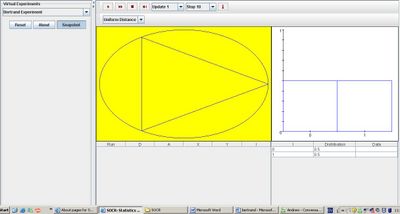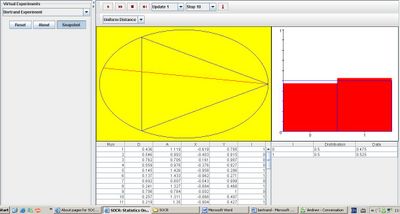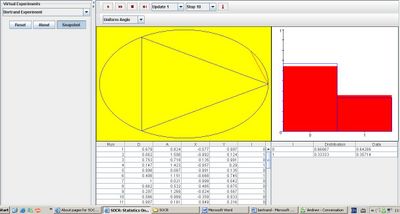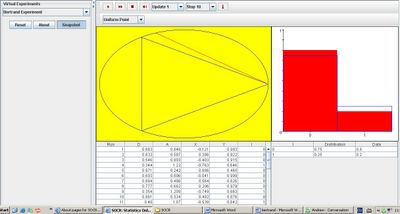SOCR EduMaterials Activities BertrandExperiment
From Socr
(→Goal) |
(→Goal) |
||
| Line 18: | Line 18: | ||
To provide a simple generator that displays different models that satisfy the geometric properties of a Bertrand experiment. | To provide a simple generator that displays different models that satisfy the geometric properties of a Bertrand experiment. | ||
| - | + | == Experiments == | |
Go to the SOCR Experiment [[http://www.socr.ucla.edu/htmls/SOCR_Experiments.html]] and select the Bertrand’s Experiment from the drop-down list of experiments on the top left. The image below shows the initial view of this experiment: | Go to the SOCR Experiment [[http://www.socr.ucla.edu/htmls/SOCR_Experiments.html]] and select the Bertrand’s Experiment from the drop-down list of experiments on the top left. The image below shows the initial view of this experiment: | ||
| Line 27: | Line 27: | ||
The “update” scroll indicates nth number of trials (1, 10, 100, or 1000) performed when selecting the fast forward button and the “stop” scroll indicates the maximum number of trials in the experiment. | The “update” scroll indicates nth number of trials (1, 10, 100, or 1000) performed when selecting the fast forward button and the “stop” scroll indicates the maximum number of trials in the experiment. | ||
| - | + | '''Uniform Distance''' | |
When “Uniform Distance” is selected from the list box, the density of ''I'' graph is symmetric. As the number of trials increase, the empirical density of ''I'' eventually takes the same form of the density graph. The image below demonstrates this outcome: | When “Uniform Distance” is selected from the list box, the density of ''I'' graph is symmetric. As the number of trials increase, the empirical density of ''I'' eventually takes the same form of the density graph. The image below demonstrates this outcome: | ||
| Line 33: | Line 33: | ||
<center>[[Image:SOCR_Activities_BertrandExperiment_Chui_0501107_Fig2.jpg|400px]]</center> | <center>[[Image:SOCR_Activities_BertrandExperiment_Chui_0501107_Fig2.jpg|400px]]</center> | ||
| - | + | '''Uniform Angle''' | |
When “Uniform Angle” is selected from the list box, the density of ''I'' graph is not symmetric—the density value of 0 is larger than that of 1. Similarly, as the number of trials increase, the empirical density of ''I'' eventually takes the same form of the density graph. The image below demonstrates this outcome: | When “Uniform Angle” is selected from the list box, the density of ''I'' graph is not symmetric—the density value of 0 is larger than that of 1. Similarly, as the number of trials increase, the empirical density of ''I'' eventually takes the same form of the density graph. The image below demonstrates this outcome: | ||
<center>[[Image:SOCR_Activities_BertrandExperiment_Chui_0501107_Fig3.jpg|400px]]</center> | <center>[[Image:SOCR_Activities_BertrandExperiment_Chui_0501107_Fig3.jpg|400px]]</center> | ||
| - | + | '''Uniform Point''' | |
When “Uniform Point” is selected from the list box, the density graph shown in blue displays a much larger value for 0, thus creating a very small value for 1. This shows that the probability of a chord exceeding the length of one side of the inscribed triangle is very small. As the number of trials increase, the empirical density of ''I'' eventually takes the same form of the density graph. The image below demonstrates this outcome: | When “Uniform Point” is selected from the list box, the density graph shown in blue displays a much larger value for 0, thus creating a very small value for 1. This shows that the probability of a chord exceeding the length of one side of the inscribed triangle is very small. As the number of trials increase, the empirical density of ''I'' eventually takes the same form of the density graph. The image below demonstrates this outcome: | ||
Revision as of 03:51, 13 May 2007
Contents |
Bertrand Experiment
Description
The Bertrand’s experiment generates a random chord of a circle with one point fixed at (1,0).
In the table, a random point (X,Y) is recorded on each update as well as D, the length of the line segment from the center of the circle to the center of the chord, and A, the angle that this line segment makes with the horizontal. Variable I indicates the event that the chord is longer than the length of a side of the inscribed equilateral triangle with 0 as shorter than the length of a side and 1 as longer than the length of a side. The density and empirical density of I is recorded in the distribution table.
On each update, the density of I is shown in blue and the empirical density of I is shown in red in the distribution graph.
Three different models can be selected with the list box: 1. The model where the distance D is uniformly distributed 2. The model where angle A is uniformly distributed 3. The model where the coordinate X is uniformly distributed
Goal
To provide a simple generator that displays different models that satisfy the geometric properties of a Bertrand experiment.
Experiments
Go to the SOCR Experiment [[1]] and select the Bertrand’s Experiment from the drop-down list of experiments on the top left. The image below shows the initial view of this experiment:

When pressing the play button, one trial will be executed and recorded in the distribution table below. The fast forward button symbolizes the nth number of trials to be executed each time. The stop button ceases any activity and is helpful when the experimenter chooses “continuous,” indicating an infinite number of events. The fourth button will reset the entire experiment, deleting all previous information and data collected. The “update” scroll indicates nth number of trials (1, 10, 100, or 1000) performed when selecting the fast forward button and the “stop” scroll indicates the maximum number of trials in the experiment.
Uniform Distance
When “Uniform Distance” is selected from the list box, the density of I graph is symmetric. As the number of trials increase, the empirical density of I eventually takes the same form of the density graph. The image below demonstrates this outcome:

Uniform Angle When “Uniform Angle” is selected from the list box, the density of I graph is not symmetric—the density value of 0 is larger than that of 1. Similarly, as the number of trials increase, the empirical density of I eventually takes the same form of the density graph. The image below demonstrates this outcome:

Uniform Point When “Uniform Point” is selected from the list box, the density graph shown in blue displays a much larger value for 0, thus creating a very small value for 1. This shows that the probability of a chord exceeding the length of one side of the inscribed triangle is very small. As the number of trials increase, the empirical density of I eventually takes the same form of the density graph. The image below demonstrates this outcome:

Applications
The Bertrand Experiment is an example of statistics and probability involving geometry. When selecting an experiment from the perspective of uniform point, angle, or distance, the density of variable I vary in respect. This simulation may be used for architectures and engineers when determining the density of a randomly sampled length of material for a given sample of area.
Translate this page:
|
[http://wiki.stat.ucla.edu/socr/index.php?title=SOCR_Edu
Materials_Activities_BertrandExperiment (default)] |
[http://translate.google.com/translate?u=http://wiki.stat.ucla.edu/socr/index.php?title=SOCR_Edu
Materials_Activities_BertrandExperiment&langpair=en%7Cde&hl=en&ie=UTF-8&oe=UTF-8&prev=%2Flanguage_tools Deutsch] |
[http://translate.google.com/translate?u=http://wiki.stat.ucla.edu/socr/index.php?title=SOCR_Edu
Materials_Activities_BertrandExperiment&langpair=en%7Ces&hl=en&ie=UTF-8&oe=UTF-8&prev=%2Flanguage_tools Español] |
[http://translate.google.com/translate?u=http://wiki.stat.ucla.edu/socr/index.php?title=SOCR_Edu
Materials_Activities_BertrandExperiment&langpair=en%7Cfr&hl=en&ie=UTF-8&oe=UTF-8&prev=%2Flanguage_tools Français] |
[http://translate.google.com/translate?u=http://wiki.stat.ucla.edu/socr/index.php?title=SOCR_Edu
Materials_Activities_BertrandExperiment&langpair=en%7Cit&hl=en&ie=UTF-8&oe=UTF-8&prev=%2Flanguage_tools Italiano] |
[http://translate.google.com/translate?u=http://wiki.stat.ucla.edu/socr/index.php?title=SOCR_Edu
Materials_Activities_BertrandExperiment&langpair=en%7Cpt&hl=en&ie=UTF-8&oe=UTF-8&prev=%2Flanguage_tools Português] |
[http://translate.google.com/translate?u=http://wiki.stat.ucla.edu/socr/index.php?title=SOCR_Edu
Materials_Activities_BertrandExperiment&langpair=en%7Cja&hl=en&ie=UTF-8&oe=UTF-8&prev=%2Flanguage_tools 日本語] |
[http://translate.google.com/translate?u=http://wiki.stat.ucla.edu/socr/index.php?title=SOCR_Edu
Materials_Activities_BertrandExperiment&langpair=en%7Cbg&hl=en&ie=UTF-8&oe=UTF-8&prev=%2Flanguage_tools България] |
[http://translate.google.com/translate?u=http://wiki.stat.ucla.edu/socr/index.php?title=SOCR_Edu
Materials_Activities_BertrandExperiment&langpair=en%7Car&hl=en&ie=UTF-8&oe=UTF-8&prev=%2Flanguage_tools الامارات العربية المتحدة] |
[http://translate.google.com/translate?u=http://wiki.stat.ucla.edu/socr/index.php?title=SOCR_Edu
Materials_Activities_BertrandExperiment&langpair=en%7Cfi&hl=en&ie=UTF-8&oe=UTF-8&prev=%2Flanguage_tools Suomi] |
[http://translate.google.com/translate?u=http://wiki.stat.ucla.edu/socr/index.php?title=SOCR_Edu
Materials_Activities_BertrandExperiment&langpair=en%7Chi&hl=en&ie=UTF-8&oe=UTF-8&prev=%2Flanguage_tools इस भाषा में] |
[http://translate.google.com/translate?u=http://wiki.stat.ucla.edu/socr/index.php?title=SOCR_Edu
Materials_Activities_BertrandExperiment&langpair=en%7Cno&hl=en&ie=UTF-8&oe=UTF-8&prev=%2Flanguage_tools Norge] |
|
[http://translate.google.com/translate?u=http://wiki.stat.ucla.edu/socr/index.php?title=SOCR_Edu
Materials_Activities_BertrandExperiment&langpair=en%7Cko&hl=en&ie=UTF-8&oe=UTF-8&prev=%2Flanguage_tools 한국어] |
[http://translate.google.com/translate?u=http://wiki.stat.ucla.edu/socr/index.php?title=SOCR_Edu
Materials_Activities_BertrandExperiment&langpair=en%7Czh-CN&hl=en&ie=UTF-8&oe=UTF-8&prev=%2Flanguage_tools 中文] |
[http://babelfish.altavista.com/babelfish/trurl_pagecontent?lp=en_zt&trurl=http://wiki.stat.ucla.edu/socr/index.php?title=SOCR_Edu
Materials_Activities_BertrandExperiment 繁体中文] |
[http://babelfish.altavista.com/babelfish/trurl_pagecontent?lp=en_ru&trurl=http://wiki.stat.ucla.edu/socr/index.php?title=SOCR_Edu
Materials_Activities_BertrandExperiment Русский] |
[http://babelfish.altavista.com/babelfish/trurl_pagecontent?lp=en_nl&trurl=http://wiki.stat.ucla.edu/socr/index.php?title=SOCR_Edu
Materials_Activities_BertrandExperiment Nederlands] |
[http://babelfish.altavista.com/babelfish/trurl_pagecontent?lp=en_el&trurl=http://wiki.stat.ucla.edu/socr/index.php?title=SOCR_Edu
Materials_Activities_BertrandExperiment Ελληνικά] |
[http://translate.google.com/translate?u=http://wiki.stat.ucla.edu/socr/index.php?title=SOCR_Edu
Materials_Activities_BertrandExperiment&langpair=en%7Chr&hl=en&ie=UTF-8&oe=UTF-8&prev=%2Flanguage_tools Hrvatska] |
[http://translate.google.com/translate?u=http://wiki.stat.ucla.edu/socr/index.php?title=SOCR_Edu
Materials_Activities_BertrandExperiment&langpair=en%7Ccs&hl=en&ie=UTF-8&oe=UTF-8&prev=%2Flanguage_tools Česká republika] |
[http://translate.google.com/translate?u=http://wiki.stat.ucla.edu/socr/index.php?title=SOCR_Edu
Materials_Activities_BertrandExperiment&langpair=en%7Cda&hl=en&ie=UTF-8&oe=UTF-8&prev=%2Flanguage_tools Danmark] |
[http://translate.google.com/translate?u=http://wiki.stat.ucla.edu/socr/index.php?title=SOCR_Edu
Materials_Activities_BertrandExperiment&langpair=en%7Cpl&hl=en&ie=UTF-8&oe=UTF-8&prev=%2Flanguage_tools Polska] |
[http://translate.google.com/translate?u=http://wiki.stat.ucla.edu/socr/index.php?title=SOCR_Edu
Materials_Activities_BertrandExperiment&langpair=en%7Cro&hl=en&ie=UTF-8&oe=UTF-8&prev=%2Flanguage_tools România] |
[http://translate.google.com/translate?u=http://wiki.stat.ucla.edu/socr/index.php?title=SOCR_Edu
Materials_Activities_BertrandExperiment&langpair=en%7Csv&hl=en&ie=UTF-8&oe=UTF-8&prev=%2Flanguage_tools Sverige] |
